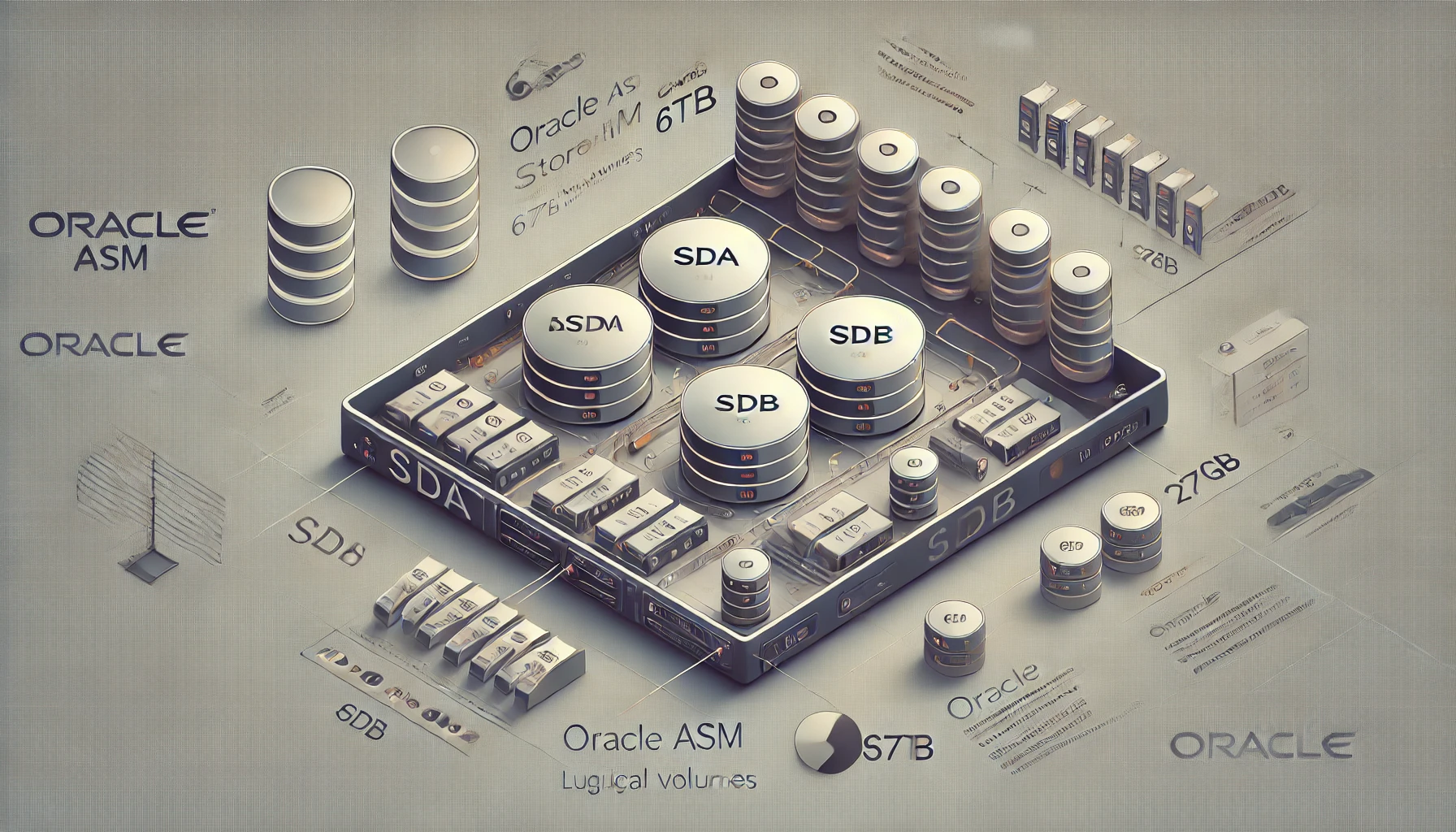Physical Address
304 North Cardinal St.
Dorchester Center, MA 02124
Physical Address
304 North Cardinal St.
Dorchester Center, MA 02124

In this guide, I’ll walk you through how I prepared disks for an Oracle environment, where sda was allocated for ASM (Automatic Storage Management) to store data, and sdb was configured for the /u01 directory, housing the Oracle and Grid binaries. The goal is to ensure optimal performance and reliability by isolating data storage from application binaries.
sda (6 TB): Dedicated entirely to ASM for Oracle data.sdb (278 GB): Configured to host the /u01 directory for Oracle and Grid binaries. It was initially partitioned by the OS but adjusted to create a new volume specifically for /u01.sda for ASM StorageThe 6 TB sda disk was allocated specifically for ASM. ASM provides Oracle with efficient data management and balancing, ideal for high-performance environments.
Steps Taken:
sda disk was ready for ASM configuration and to identify existing partitions on sdb. Using the lsblk command provided a clear overview of each disk and its partitions.parted to remove any existing partitions on sda, ensuring it was fully available for Oracle ASM setup: lsblk
# Enter parted interface to clear any existing partitions on /dev/sda
parted /dev/sda
(parted) rm 1 # Remove partition (if any)sda as a physical volume and then created a volume group called vg_data to organize ASM-related storage. pvcreate /dev/sda
vgcreate vg_data /dev/sdasda into logical volumes to allocate space for the ASM setup, reserving the remaining space for the last logical volume. lvcreate -L 2T -n lv_data1 vg_data
lvcreate -L 2T -n lv_data2 vg_data
lvcreate -L 2T -n lv_data3 vg_data
lvcreate -l 100%FREE -n lv_data4 vg_data # Allocates all remaining free spaceHere, lv_data4 is created using -l 100%FREE to consume the remaining unallocated space on sda, ensuring we utilize the full capacity.
lsblk, lvdisplay, and vgdisplay to confirm the setup: lsblk
lvdisplay
vgdisplaysdb for the /u01 DirectoryThe sdb disk, with 278 GB, was used for the /u01 directory, storing the Oracle and Grid binaries. Separating u01 from ASM storage improves performance and reliability by keeping the binaries and storage management on separate physical drives.
Steps Taken:
/u01:u01 with 150 GB, ensuring sufficient space for Oracle and Grid infrastructure binaries. lvcreate -n u01 -L 150G olu01 logical volume. mkfs.ext4 /dev/ol/u01/u01 directory and mounted the volume. To make the mounting persistent across reboots, I added it to /etc/fstab. mkdir /u01
echo '/dev/ol/u01 /u01 ext4 defaults 0 0' >> /etc/fstab
mount -a df -hTP
lsblkAfter the setup, here is the disk layout for ASM and the /u01 directory:
lsblk
NAME MAJ:MIN RM SIZE RO TYPE MOUNTPOINT
sdb 8:16 0 278.9G 0 disk
├─sdb2 8:18 0 277.9G 0 part
│ ├─ol-swap 252:1 0 16G 0 lvm [SWAP]
│ ├─ol-home 252:2 0 20G 0 lvm /home
│ ├─ol-root 252:0 0 50G 0 lvm /
│ └─ol-u01 252:3 0 150G 0 lvm /u01
└─sdb1 8:17 0 1G 0 part /boot
sr0 11:0 1 1024M 0 rom
sda 8:0 0 6.6T 0 disk
├─vg_data-lv_data3 252:6 0 2T 0 lvm
├─vg_data-lv_data1 252:4 0 2T 0 lvm
├─vg_data-lv_data4 252:7 0 560.5G 0 lvm
└─vg_data-lv_data2 252:5 0 2T 0 lvm This setup isolates Oracle ASM storage from the /u01 directory, which holds the Oracle and Grid binaries, improving both reliability and performance. By using separate physical disks for ASM and application binaries, this configuration is robust, ready to support demanding Oracle workloads with efficiency.
P.S. To allocate the logical volume for ASM, identify the exact path to the logical volume using lvdisplay or by specifying the volume group name, like so:
lvdisplay /dev/vg_dataThis will provide the path needed to create an ASM disk. For example, after confirming the path, create the ASM disk with the following command:
oracleasm createdisk DATA04 /dev/vg_data/lv_data4This ensures the logical volume is correctly allocated for ASM, ready for use in Oracle storage management.